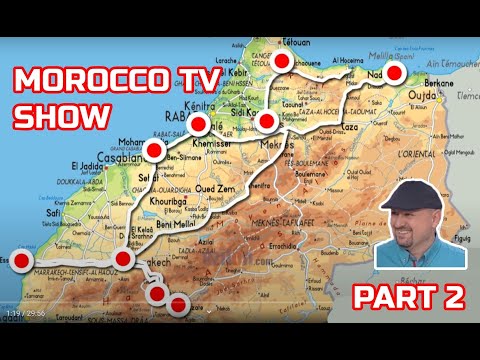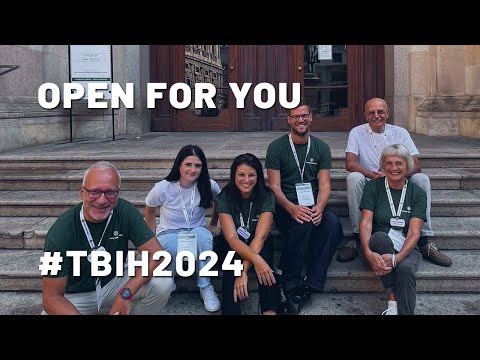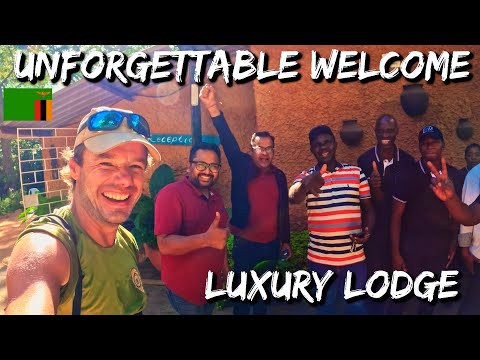MOROCCO TV SHOW - Part 2 - BROADCASTED ON 6 TV STATIONS IN SERBIA Serbian language English subtitle

Welcome! Your guide Serbian on the road. I will take you through the beautiful African land of the Orient - Morocco Stay with me to the end and get to know the biggest attractions of Morocco: see royal cities, palaces and ancient fortifications, enjoy culinary specialties, learn traditional crafts and local products you will see amazing colors of Morocco meet caravan routes in the Sahara desert and mystical cities and Atlas Mountains and meet daily life of the people of this region. Once again - welcome to Morocco My journey begins in the far north, in the city of Nador, from where I travel all night by train to the capital - Rabat.
The next destinations are Casablanca, then Marrakech From Marrakech, a short trip to the fishing town of Essaouira follows, then the road to the famous place in the Ait Benhadou desert and the town of the unusual name Ouarzazate. I return to Marrakech again, so I embark on a long journey to the beautiful and very interesting city of Fes The road takes me further to the blue city of Chefchaouen, so I return to Nador and end my tour of Morocco. I covered about 3,000 kilometers in February 2020, just before the pandemic The road to the famous city in the Desert - Ait Ben Hadou leads over the peaks of Mount Atlas. We take the first break at 1000 m above sea level. in the part of the mountain that faces the Atlantic Ocean, so the moisture that comes from the ocean affects the growth of trees, so we are surrounded by greenery. We take the second break at an altitude of 2000 m above sea level and the landscape is completely different.
There are no more trees here, and no grass. This part is facing the Sahara and here the climate is completely different. There is still snow on the surrounding peaks, and some 100 km from here is the highest peak of Morocco - Tubkal. With its 4,167 m, it is the second highest peak in Africa, right after Kilimanjaro. To get to the old city we go through the new city. This is a new part of the city where there is electricity and water, and all the families from the old town have moved to live here.
There is no electricity or water in the old part of the city, and only a few inhabitants remain. The old town is in charge of tourists. This is a cafe with probably the most beautiful view of Ait Ben Hadou.
To get to the city, we need to cross a river that is specific for non-drinking water. The high salt content made it impossible to consume it, but it was this salt that once meant wealth for the inhabitants of this city, who sold it to caravans on their way through the Sahara. Most of these 17th-century buildings are made of compacted earth, clay and straw, and the city is under UNESCO protection.
I am attending just one unusual artistic creation. The gentleman in paints the paper with various materials, from which the image will be formed only when the paper is placed over a fire. See what it looks like. To get to the top of the city, we go through unusual tunnels from some ancient epochs. Our guide found out that I was from Serbia, so he wanted to greet you.
The unique appearance of the city led to the fact that a large number of movies were made in it. I will mention only the most famous - Gladiator, Mummy, Prince of Persia, Marco Polo, Alexander and many others, and one of the most popular TV series - Game of Thrones. From the top there is a fantastic view. In the distance you can see the Atlas Mountains over which we came. Below us is the new city of Ait Ben Hadou with a salt river and everything else is the Sahara Desert. The famous city in the desert is visited by tourists from all over the world, and I am somehow glad that Angelina Joli was walking here relatively recently.
I managed to find out more about this. This first gate in front of us was made for the needs of the movie Gladiator, but it drowned so well in the environment that they decided to leave it. Another big greeting for the legendary city in the desert - Ait Ben Hadou. The next city bears the unusual name Ouarzazate and is known for having several large film studios. I take a short break, I have a long way to go over the Atlas Mountains, back to Marrakech and then another 450 km to the incredibly interesting city of Fes. The royal city of Fes (some call it Fez) is known as another major tourist attraction.
The famous red hat with a tassel was once produced only here a long time ago, and was named after this city. And here is another beautiful royal palace. The exceptional ornamentation and beauty of the palace enchant, and the richly decorated gilded doors give this palace a look worthy of a king.
I stop by a local restaurant. The traditional Moroccan appetizer consists of a dozen salads: olives, peppers, beets, cucumber, green beans, potatoes. Bread is unavoidable, incredibly tasty and high quality. The main dish is the famous Tajin, which is prepared in clay closed vessels, and the meat prepared in them melts in the mouth. I ordered lamb with almonds and vegetables and some from the team ordered chicken.
Squeezed fruit juice is unavoidable, which is the best thing for refreshment in Morocco. One of the symbols of Fes are tanneries. These are traditional family leather processing factories, which use the same methods as 1000 years ago. To soften the skin, it is first placed in pools that are filled with a liquid with a catastrophic smell. The ingredients are as follows: cow urine, pigeon droppings and salt. Visitors are given sprigs of mint at the entrance, to keep under the nose, to alleviate the unpleasant smell.
After a few days in these pools, the skin softens, so it is transferred to other pools filled with natural colors, where it spends a few more days. The result is top quality leather products of exceptional quality. From the top of this building you can see why Fes is called the Yellow City. This unusual fruit is called a thermos They are freshly picked and cleaned and the price is very affordable. You can eat about 10 pieces for 1 euro.
In the center of Fes is a small oasis - a beautiful park of French name Jeanne Zbil. Tourists and locals also come here, and it is located near the main entrance to the medina. The city was founded at the end of the VIII century, when the oldest university in the world was opened (which is still working) and the oldest medina in the world was opened (and is still working). The main entrance to the medina is this beautiful and famous Blue Gate. I enter Medina, the largest human settlement in the world without traffic.
Local specialties are on offer. Like fish, says the lady The king of Morocco also comes to this butcher shop, says the seller (at least he is in the photo), and I was attracted by these camel heads - an offer that is not seen very often. This is a local fast food that I tried in several places and it is great.
A young guy separates camel meat from bones, and I'm thinking of trying some camel... This is camel meat. I will try it for the first time in my life I asked from them not to put spices, so I can feel the meat So, these are stakes of camel meat There are some spices, but that is minimal Help me God Something between beef and chicken, more like beef I can say it is great! It is good to have camel in sandwich Medina in Fes is a labyrinth of 9000 streets in which several hundred thousand people live and move exclusively on foot. The only means of transport used here are donkeys. Another important note is that any navigation or application with maps does not help you here, you have to manage on your own, because all the streets are intersected by tunnels, passages and incredibly intricate shortcuts. Some parts of the medina date back to the eighth century, and the streets are narrow to provide as much shade as possible in summer, because temperatures go over 40 degrees. At the market you can buy everything from food and clothes, spices and sweets to souvenirs, and I am slowly preparing to set off for the famous blue city of Chefchaouen.
When you look at Chefsauen from a distance, only a few blue buildings can be seen, but we will get to know the real beauty of the city by walking through its streets. Whole city is beautiful, so I decided to shoot on the go. Take a walk with me through the streets of the Blue City - Chefchaouen. Chefchaouen is a preety town located on the Rif mountain at 610 m above sea level.
The main square and the fortress date from the 15th century, and the blue color is attributed to the Jews who painted the facades due to religious symbols. For many centuries, the city was forbidden to tourists because it was considered sacred. Today it is one of the largest tourist centers and everything is dedicated to tourism. There are public fountains in many places in the city, and one of the things that surprised me a lot was that you can find a glass in each of which all passers-by drink water from. I note that the material was recorded just before the outbreak of the pandemic, so I assume that this is one of the last recordings of this unusual custom. This is a beautiful Moroccan Chinese restaurant.
The city is full of beautiful squares reminiscent of Spanish and Italian towns, and life in this part of the city is unusually quiet because there are no cars. I think the most beautiful experience is simply wandering the winding streets, narrow stairs and enjoying the countless shades of blue. For fans of souvenirs and photography, I think this is the best destination they can imagine. My tour of Morocco is slowly coming to an end, I have seen many things, but still left a lot to see I hope that you have felt at least part of the atmosphere from the road and enjoyed in this beautifull country, nice people, rich history and tradition, and that we will meet again very soon And finally listen to once again the biggest hit of 2020, directly from Marrakesh, just for you the song: Serbia, Serbia
2021-10-09 13:42


